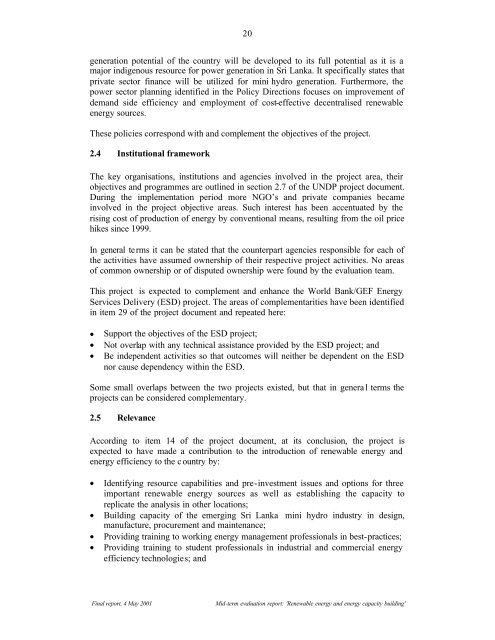Mid-term Evaluation Report Sri Lanka - Unido
Mid-term Evaluation Report Sri Lanka - Unido
Mid-term Evaluation Report Sri Lanka - Unido
You also want an ePaper? Increase the reach of your titles
YUMPU automatically turns print PDFs into web optimized ePapers that Google loves.
20<br />
generation potential of the country will be developed to its full potential as it is a<br />
major indigenous resource for power generation in <strong>Sri</strong> <strong>Lanka</strong>. It specifically states that<br />
private sector finance will be utilized for mini hydro generation. Furthermore, the<br />
power sector planning identified in the Policy Directions focuses on improvement of<br />
demand side efficiency and employment of cost-effective decentralised renewable<br />
energy sources.<br />
These policies correspond with and complement the objectives of the project.<br />
2.4 Institutional framework<br />
The key organisations, institutions and agencies involved in the project area, their<br />
objectives and programmes are outlined in section 2.7 of the UNDP project document.<br />
During the implementation period more NGO’s and private companies became<br />
involved in the project objective areas. Such interest has been accentuated by the<br />
rising cost of production of energy by conventional means, resulting from the oil price<br />
hikes since 1999.<br />
In general <strong>term</strong>s it can be stated that the counterpart agencies responsible for each of<br />
the activities have assumed ownership of their respective project activities. No areas<br />
of common ownership or of disputed ownership were found by the evaluation team.<br />
This project is expected to complement and enhance the World Bank/GEF Energy<br />
Services Delivery (ESD) project. The areas of complementarities have been identified<br />
in item 29 of the project document and repeated here:<br />
• Support the objectives of the ESD project;<br />
• Not overlap with any technical assistance provided by the ESD project; and<br />
• Be independent activities so that outcomes will neither be dependent on the ESD<br />
nor cause dependency within the ESD.<br />
Some small overlaps between the two projects existed, but that in genera l <strong>term</strong>s the<br />
projects can be considered complementary.<br />
2.5 Relevance<br />
According to item 14 of the project document, at its conclusion, the project is<br />
expected to have made a contribution to the introduction of renewable energy and<br />
energy efficiency to the c ountry by:<br />
• Identifying resource capabilities and pre-investment issues and options for three<br />
important renewable energy sources as well as establishing the capacity to<br />
replicate the analysis in other locations;<br />
• Building capacity of the emerging <strong>Sri</strong> <strong>Lanka</strong> mini hydro industry in design,<br />
manufacture, procurement and maintenance;<br />
• Providing training to working energy management professionals in best-practices;<br />
• Providing training to student professionals in industrial and commercial energy<br />
efficiency technologies; and<br />
Final report, 4 May 2001<br />
<strong>Mid</strong>-<strong>term</strong> evaluation report: 'Renewable energy and energy capacity building'
















